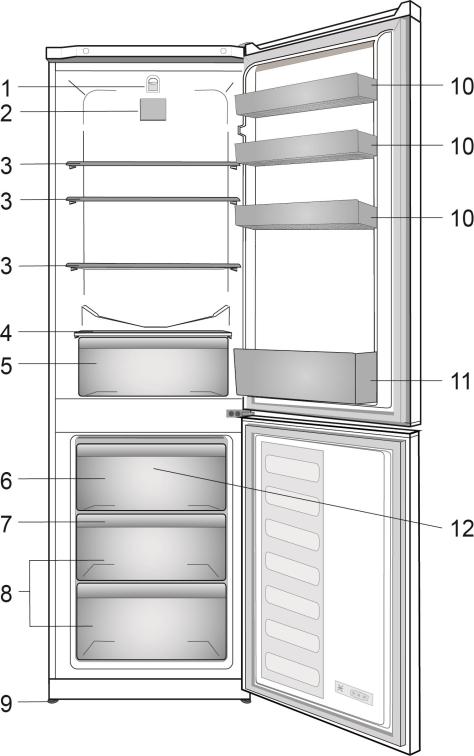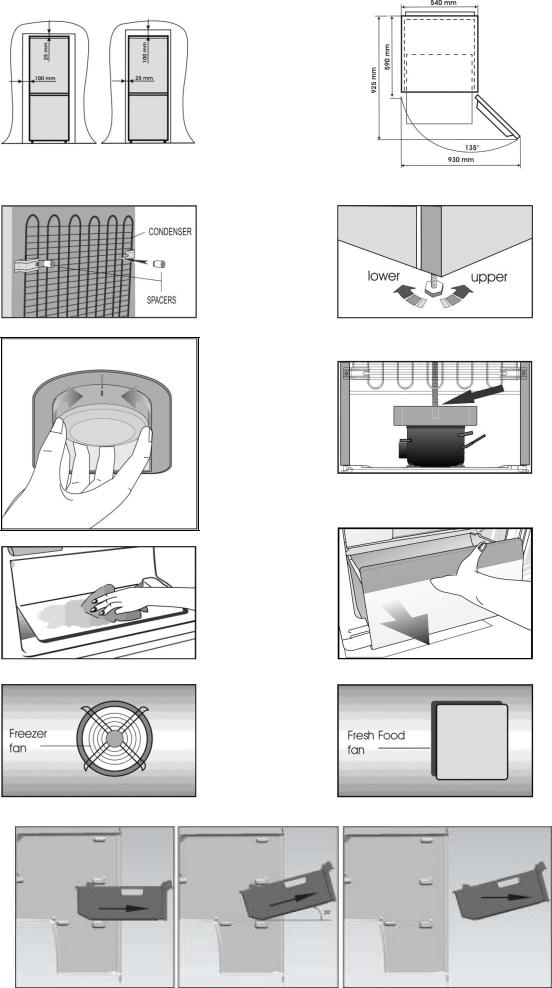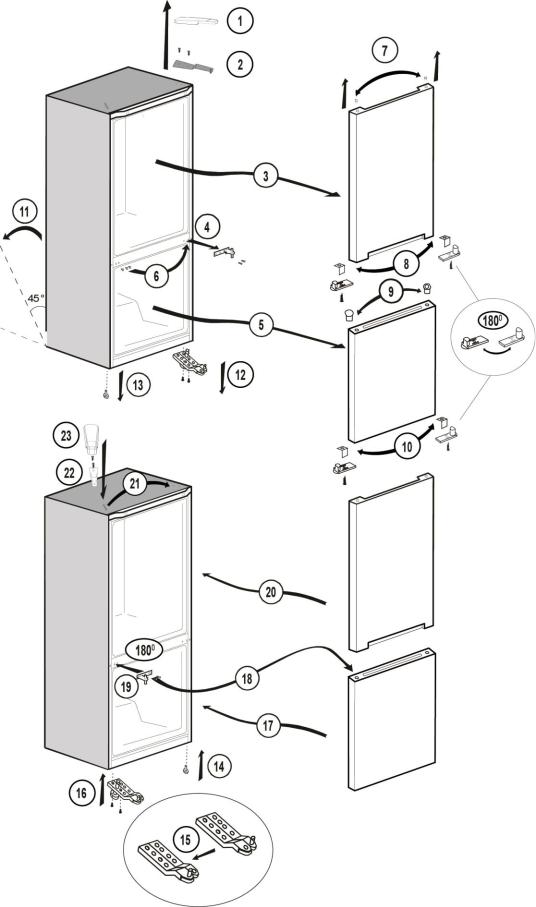BEKO RCNA305K20S User Manual

Frost Free Refrigerator-Freezer type I |
RCNA305K20S |
Незамерзаюче Холодильник-Морозильник типу I |
|
Незамерзающее Холодильник-Морозильник типа I |
|
Réfrigérateur-Congélateur type I |
|
|
|

WARNING!
In order to ensure a normal operation of your refrigerating appliance, which uses a completely environmentally friendly refrigerant the R600a (flammable only under certain conditions) you must observe the following rules:
Do not hinder the free circulation of the air around the appliance.
Do not use mechanical devices in order to accelerate the defrosting, others than the ones recommended by the manufacturer.
Do not destroy the refrigerating circuit.
Do not use electric appliances inside the food keeping compartment, other than those that might have been recommended by the manufacturer.
УВАГА!
Для того, щоб забезпечити нормальну роботу Вашого холодильника, в якому використовується охолоджуючий реагент R600a, абсолютно нешкідливий для навколишнього середовища (займається лише за певних умов), Вам Необхідно дотримуватися наступних правил..
Не створюйте перепон для вільної циркуляції повітря навколо холодильника.
Не користуйтесь жодними механічними пристроями та інструментами для видалення льоду під час розморожування холодильника, окрім тих, що рекомендовані виробником.
Не допускайте пошкодження охолоджуючого контура.
Не встановлюйте всередину холодильного відділення, де зберігаються продукти, жодних електричних пристроїв, окрім тих, що рекомендовані виробником.
ВНИМАНИЕ
Для того, чтобы обеспечить нормальную работу Вашего холодильника в котором используется охлаждающий реагент R600a, совершенно безвредный для окружающей среды (воспламеняющийся только в определенных условиях), Вам следует соблюдать следующие правила.
Не создавайте препятствий для свободной циркуляции воздуха вокруг холодильника.
Не пользуйтесь никакими механическими приспособлениями и инструментами для удаления льда при размораживании холодильника, коме тех, которые рекомендованы изготовителем.
Не допускайте повреждения охлаждающего контура.
Не устанавливайте внутрь холодильного отделения, где хранятся продукты, никакие электрические устройства, кроме тех, которые рекомендованы изготовителем.
ATTENTION!
Pour assurer un fonctionnement normal de votre appareil qui utilise un agent frigorifique écologique, R600a (infammable seulement sous certaines conditions) vous devez respecter les règles suivantes:
N’empêchez pas la libre circulation de l’air autour de l’appareil.
N’ utilisez pas des dispositifs mécaniques pour accélérer le dégivrage, autres que ceux récommendés par le fabriquant.
Ne détruissez pas le circuit frigorifique.
N’utilisez pas des appareils électiques à l’intérieur du compartiment pourconserver les aliments, hormi celles qui sont éventuellement récommendés par le fabriquant.

GB Index
Safety first /1
Electrical requirements /2 Transportation instructions /2 Installation instructions /2 Getting to know your appliance /3
Suggested arrangement of food in the appliance /3 Temperature control and adjustment /4
Before operating /4 Storing frozen food /4 Freezing fresh food /4 Making ice cubes /4 Defrosting /5
Replacing the interior light bulb /5 Cleaning and care /5 Repositioning the door /6
Do’s and don’ts /6
Energy Consumption /7
Information concerning the noises /8 Troubleshooting /8
УA Зміст
Безпека передусім! /9 Порядок підключення до електромережі /10
Інструкції з транспортування /10 Інструкції щодо встановлення /10 Короткий опис приладу /11
Рекомендації щодо розміщення продуктів у холодильнику /11 Контроль і регулювання температури /11 Перед експлуатацією /12
Зберігання заморожених продуктів /12 Заморожування свіжих продуктів /12 Приготування кубиків льоду /12 Розморожування /13 Заміна лампочки внутрішнього освітлення /13 Чищення та догляд /13
Перенавішування дверцят /14 Що слід і чого не слід робити /14
Інформація щодо робочих шумів /15 Енергоспоживання /16 Усунення несправностей /16
РУС Coдepжаниe
Безопасность прежде всего /18 Требования к электропитанию /19 Инструкция по транспортировке /19 Инструкция по установке /19 Ознакомление с прибором /20
Рекомендуемый способ размещения продуктов в холодильнике /20 Контроль и регулировка температуры /20 Перед началом работы /21
Хранение замороженных продуктов /21 Замораживание свежих продуктов /21 Приготовление кубиков льда /22 Размораживание /22 Замена лампочки внутреннего освещения /22
Чистка холодильника и уход за ним /23 Перевешивание двери /23 Что следует и чего не следует делать /24 Энергопотребление /25 Вибрация и шум /25
Устранение неисправностей /26
FR Sommaire
Premièrement la sécurite! /27 Avertissements et conseils importants /28 Installation /28
Branchement au réseau /29 Présentation de l’appareil /29 Réversibilité de la porte /29 Mise en fonctionnement /29
Entreposage des produits a conserver /29
Remplacement de l’ampoule /29 Réglage de la température /30 Congélation des produits frais /30 Conservation des produits congelés /31 Production des cubes des glace /31 Dégivrage /31
Nettoyage /32
Consommation énergétique /33 Remarques sur les éventuiels bruits /33

 Figures that take place in this instruction manual are schematic and may not correspond exactly with your product. If the subject parts are not included in the product you have purchased, then it is valid for other models.
Figures that take place in this instruction manual are schematic and may not correspond exactly with your product. If the subject parts are not included in the product you have purchased, then it is valid for other models.
Ілюстрації в даній інструкції є схематичними і можуть відрізнятися від вашої моделі. Якщо до комплектації моделі, яку ви придбали, не входять вказані деталі, вони призначені для інших моделей.
Иллюстрации в данной инструкции являются схематичными и могут не соответствовать вашей модели. Некоторые компоненты, которые не входят в состав приобретенного вами изделия, используются в других моделях.
Les illustrations présentées dans cette notice d’utilisation sont schématiques et peuvent ne pas correspondre exactement à votre produit. Si certains fonctions ne sont pas inclus dans le produit que vous avez acheté, ils concerneront d’autres modèles.

2
3 |
4 |
6
5
7 |
8 |
9 |
10 |
11

12

GB |
Instruction for use |
|
|
Congratulations on your choice of a BEKO Quality
Appliance, designed to give you many years of service.
Safety first!
Do not connect your appliance to the electricity supply until all packing and transit protectors have been removed.
•Leave to stand for at least 4 hours before switching on, to allow compressor oil to settle, if transported horizontally.
•If you are discarding an old appliance with a lock or latch fitted to the door, ensure that it is left in a safe condition to prevent the entrapment of children.
•This appliance must only be used for its intended purpose.
•Do not dispose of the appliance on a fire. Your appliance contains non CFC substances in the insulation which are flammable. We suggest you contact your local authority for information on disposal and available facilities.
•We do not recommend use of this appliance in an unheated, cold room. (e.g. garage, conservatory, annex, shed, out-house etc.)
To obtain the best possible performance and trouble free operation from your appliance it is very important to read these instructions carefully. Failure to observe these instructions may invalidate your right to free service during the guarantee period.
Please keep these instructions in a safe place for easy reference.
Original Spare parts will be provided for 10 years, following the product purchasing date.
This appliance is not intended for use by person with reduced physical, sensory or mental capabilities or lack of experience and knowledge unless they have been given supervision or instruction concerning use of the appliance by a person responsible for their safety.
Children should be supervised to ensure that they do not play with the appliance.
1
GB |
Instruction for use |
|
|
Electrical requirements
Before inserting the plug into the wall socket make sure that the voltage and the frequency shown in the rating plate inside the appliance corresponds to your electricity supply.
We recommend that this appliance is connected to the mains supply via a suitably switched and fused socket in a readily accessible position.
Warning! This appliance must be earthed.
Repairs to electrical equipment should only be performed by a qualified technician. Incorrect repairs carried out by an unqualified person are carry risks that may have critical consequences for the user of the appliance.
ATTENTION!
This appliance operates with R600a which is an environmental friendly but flammable gas. During the transportation and fixing of the product, care must be taken not to damage the cooling system. If the cooling system is damaged and there is a gas leakage from the system, keep the product away from open flame sources and ventilate the room for a while.
WARNING - Do not use mechanical devices or other means to accelerate the defrosting process, others than those recommended by the manufacturer.
WARNING - Do not damage the refrigerant circuit. WARNING - Do not use electrical appliances inside the food storage compartments of the appliance, unless they are of the type recommended by the manufacturer.
WARNING - If the supply cord is damaged, it must be replaced by the manufacturer, its service agent or similarly qualified persons in order to avoid a hazard.
Transportation instructions
1.The appliance should be transported only in an upright position. The packing as supplied must be intact during transportation.
2.If during the transport the appliance, has been positioned horizontally, it must not be operated for at least 4 hours, to allow the system to settle.
3.Failure to comply with the above instructions could result in damage to the appliance, for which the manufacturer will not be held liable.
4.The appliance must be protected against rain, moisture and other atmospheric influences.
Important!
•Care must be taken while cleaning/carrying the appliance not to touch the bottom of the condenser metal wires at the back of the appliance, as this could cause injury to fingers and hands.
•Do not attempt to sit or stand on top of your appliance as it is not designed for such use. You could injure yourself or damage the appliance.
•Make sure that the mains cable is not caught under the appliance during and after moving, as this could damage the cable.
•Do not allow children to play with the appliance or tamper with the controls.
Installation instructions
1.Do not keep your appliance in a room where the temperature is likely to fall below -15 degrees C (5 degrees F) at night and/or especially in winter.
2.Do not place the appliance near cookers or radiators or in direct sunlight, as this will cause extra strain on the appliance's functions. If installed next to a source of heat or freezer, maintain the following minimum side clearances: From Cookers 30 mm
From Radiators 300 mm From Freezers 25 mm
3.Make sure that sufficient room is provided around the appliance to ensure free air circulation
(Item 2).
• Put the back airing lid to the back of your refrigerator to set the distance between the refrigerator and the wall (Item 3).
4.The appliance should be positioned on a smooth surface. The two front feet can be adjusted as required.To ensure that your appliance is standing upright adjust the two front feet by turning clockwise or anti-clockwise, until firm contact is secured with the floor. Correct adjustment of feet prevents excessive vibration and noise (Item 4).
5.Refer to "Cleaning and Care" section to prepare your appliance for use.
2
GB |
Instruction for use |
|
|
Getting to know your appliance
(Item 1)
1 - Setting knob and interior light
2 - Fresh Food fan
3 - Adjustable Cabinet shelves
4 - Crisper cover
5 - Crisper
6 - Compartment for quickly freezing
7 - Ice tray support & ice tray
8 - Compartments for frozen froods keeping
9 - Adjustable foot
10 - Shelf for jars
11 - Shelf for bottles
12 - Freezer fan
The fans has the purpose to provide the circulation of the air in compartment. It is connected in parallel with the motor-compressor. When the motor-compressor is off, the fans will also be off.
Suggested arrangement of food in the appliance
Guidelines for obtaining optimum storage and hygiene:
1.The fridge compartment is for the short-term storage of fresh food and drinks.
2.The freezer compartment is  rated and suitable for the freezing and storage of
rated and suitable for the freezing and storage of
pre-frozen food.
The recommendation for  storage as stated on the food packaging should be observed at all times.
storage as stated on the food packaging should be observed at all times.
3.Dairy products should be stored in the special compartment provided in the door liner.
4.Cooked dishes should be stored in airtight containers.
5.Fresh wrapped produce can be kept on the shelf. Fresh fruit and vegetables should be cleaned and stored in the crispers.
6.Bottles can be kept in the door section.
7.To store raw meat, wrap in polythene bags and place on the lowest shelf. Do not allow to come into contact with cooked food, to avoid contamination. For safety, only store raw meat for two to three days.
8.For maximum efficiency, the removable shelves should not be covered with paper or other materials to allow free circulation of cool air.
9. Do not keep vegetable oil on door shelves. Keep the food packed, wrapped or covered. Allow hot food and beverages to cool before refrigerating. Leftover canned food should not be stored in the can.
10.Fizzy drinks should not be frozen and products such as flavoured water ices should not be consumed too cold.
11.Some fruit and vegetables suffer damage if kept at temperatures near 0°C. Therefore wrap pineapples, melons, cucumbers, tomatoes and similar produce in polythene bags.
12.High-proof alcohol must be stored upright in tightly closed containers. Never store products that contain an inflammable propellant gas (e.g. cream dispensers, spray cans, etc.) or explosive substances. These are an explosion hazard.
13.To take out the baskets from the freezer compartment please proceed as in item 11.
Temperature control and adjustment
Operating temperatures are controlled by the setting knob (Item 5) located on the ceiling of fridge compartment. Settings may be made from min,
1 ... 4, 4 being the coldest position.
When the appliance is switched on for the first time, the setting knob should be adjusted so that after 24 hours, the average fridge temperature is no higher than +5°C (+41°F). We recommend you set the knob on 1 position between the min and
4 setting and monitor to obtain the desired temperature i. e. towards max you will obtain a colder fridge temperature and vice versa. Some sections of the fridge may be cooler or warmer (such as the salad crisper and the top part of the cabinet) which is quite normal.
We recommend that you check the temperature with an accurate thermometer to ensure that the storage compartments are kept to the desired temperature.
Remember you must take your reading very quickly since the thermometer temperature will rise very rapidly after you remove it from the freezer.
Please remember each time the door is opened cold air escapes and the internal temperature rises. Therefore never leave the door open and ensure it is closed immediately after food is put in or removed.
3
GB |
Instruction for use |
|
|
Before operating
Final Check
Before you start using the appliance check that: 1. The feet have been adjusted for perfect levelling.
2. The interior is dry and air can circulate freely at the rear.
3. The interior is clean as recommended under "Cleaning and care.”
4. The plug has been inserted into the wall socket and the electricity is switched on. When the door is open the interior light will come on.
And note that:
5. You will hear a noise as the compressor starts up. The liquid and gases sealed within the refrigeration system may also make some (noise), whether the compressor is running or not. This is quite normal.
6. Slight undulation of the top of the cabinet is quite normal due to the manufacturing process used; it is not a defect.
7. We recommend setting the knob midway and monitor the temperature to ensure the appliance maintains desired storage temperatures (See section Temperature Control and Adjustment). 8. Do not load the appliance immediately it is switched on. Wait until the correct storage temperature has been reached. We recommend checking the temperature with an accurate thermometer (see; Temperature Control and Adjustment).
Storing frozen food
Your freezer is suitable for the long-term storage of commercially frozen foods and also can be used to freeze and store fresh food.
If there is a power failure, do not open the door. Frozen food should not be affected if the failure lasts for less than 16 hrs. If the failure is longer, then the food should be checked and either eaten immediately or cooked and then re-frozen.
Freezing fresh food
Please observe the following instructions to obtain the best results.
Do not freeze too large a quantity at any one time. The quality of the food is best preserved when it is frozen right through to the core as quickly as possible.
Do not exceed the freezing capacity of your appliance in 24 h.
Placing warm food into the freezer compartment causes the refrigeration machine to operate continously until the food is frozen solid. This can temporarily lead to excessive cooling of the refrigeration compartment.
When freezing fresh food, to reach the best freezing capacity, put the setting knob to maximum position 24h before placing it. After freezing the knob can be set to the initial position. Small quantities of food up to 1/2 kg. (1 lb) can be frozen without adjusting the temperature control knob.
Take special care not to mix already frozen food and fresh food.
Making ice cubes
Fill the ice - cube tray 3/4 full with water and place it in the freezer. Loosen frozen trays with a spoon handle or a similar implement; never use sharpedged objects such as knives or forks.
4
GB |
Instruction for use |
|
|
Defrosting
A) Fridge compartment
The fridge compartment defrosts automatically. The defrost water runs to the drain tube via a collection container at the back of the appliance. Check that the tube is permanently placed with its end in the collecting tray on the compressor to prevent the water spilling on the electric installation or on the floor (Item 6).
B) Freezer compartment
The NO FROST type defrost is compleetly automatic. No intervention from your side is requiered. The water is colected on the compressor tray. Due the heat of the compressor the water is evaporated.
Do not use pointed or sharp-edged objects, such as knives or forks to remove the frost.
Never use hairdryers, electrical heaters or other such electrical appliances for defrosting. Sponge out the defrost water collected in the bottom of the freezer compartment. After
defrosting, dry the interior thoroughly (Item 7 & 8). Insert the plug into the wall socket and switch on the electricity supply.
Warnings!
The fans inside the freezer and fresh food compartments circulates cold air. Never insert any object through the guard. Do not allow children to play with the fresh food andfreezer fan.
Never store products that contain inflammable propellant gas (eg dispensers, spray cans etc.) or explosive substances.
Don’t cover the shelves with any protective materials, which may obstruct air circulation.
Do not allow children to play with the appliance or tamper with the controls.
Do not obstruct the fan guards to ensure that you obtain the best possible performance from your appliance. (Item 9 and Item 10)
Warning!
Your appliance is fitted with a circulating fan which is essential for the performance of the refrigerator. Please ensure the fans are not blocked (stopped) or impaired by food or packaging. Blocking (stopping) or impairing the fan can result in an increase of the internal freezer temperature (Thawing).
Replacing the interior light bulb
To change the Bulb/LED used for illumination of your refrigerator, call your AuthorisedService.
The lamp(s) used in this appliance is not suitable for household room illumination. The intended purpose of this lamp is to assist the user to place foodstuffs in the refrigerator/freezer in a safe and comfortable way.
The lamps used in this appliance have to withstand extreme physical conditions such as temperatures below -20°C.
Cleaning and care
1.We recommend that you switch off the appliance at the socket outlet and pull out the mains plug before cleaning.
2.Never use any sharp instruments or abrasive substances, soap, household cleaner, detergent or wax polish for cleaning.
3.Use luke warm water to clean the cabinet of the appliance and wipe it dry.
4.Use a damp cloth wrung out in a solution of one teaspoon of bicarbonate of soda to one pint of water to clean the interior and wipe it dry.
5.Make sure that no water enters the temperature control box.
6.If the appliance is not going to be used for a long period of time, switch it off, remove all food, clean it and leave the door ajar.
7.We recommend that you polish the metal parts of the product (i.e. door exterior, cabinet sides) with a silicone wax (car polish) to protect the high quality paint finish.
8.Any dust that gathers on the condenser, which is located at the back of the appliance, should be removed once a year with a vacuum cleaner.
9.Check door seals regularly to ensure they are clean and free from food particles.
10. Never:
•Clean the appliance with unsuitable material; eg petroleum based products.
•Subject it to high temperatures in any way,
•Scour, rub etc., with abrasive material.
5
GB |
Instruction for use |
|
|
11. Removal of dairy cover and door tray :
•To remove the dairy cover, first lift the cover up by about an inch and pull it off from the side where there is an opening on the cover.
•To remove a door tray, remove all the contents and then simply push the door tray upwards from the base.
12. Make sure that the special plastic container at the back of the appliance which collects defrost water is clean at all times. If you want to remove the tray to clean it, follow the instructions below:
•Switch off at the socket outlet and pull out the mains plug
•Gently uncrimp the stud on the compressor, using a pair of pliers, so that the tray can be removed
•Lift it up.
•Clean and wipe it dry
•Reassemble, reversing the sequence and operations
13. To remove a drawer, pull it as far as possible, tilt it upwards and then pull it out completely.
Repositioning the door
Proceed in numerical order (Item 12).
Do’s and don’ts
Do- Clean your appliance regularly.
Do- Keep raw meat and poultry below cooked food and dairy products.
Do- Take off any unusable leaves on vegetables and wipe off any soil.
Do- Leave lettuce, cabbage, parsley and cauliflower on the stem.
Do- Wrap cheese firstly in greaseproof paper and then in a polythene bag, excluding as much air as possible. For best results, take out of the fridge compartment an hour before eating.
Do- Wrap raw meat and poultry loosely in polythene or aluminium foil. This prevents drying.
Do- Wrap fish and offal in polythene bags.
Do- Wrap food with a strong odour or which may dry out, in polythene bags, or aluminium foil or place in airtight container.
Do- Wrap bread well to keep it fresh.
Do- Chill white wines, beer, lager and mineral water before serving.
Do- Check contents of the freezer every so often. Do- Keep food for as short a time as possible
and adhere to "Best Before" and "Use by" etc. dates.
Do- Store commercially frozen food in accordance with the instructions given on the packets.
Do- Always choose high quality fresh food and be sure it is thoroughly clean before you freeze it.
Do- Prepare fresh food for freezing in small portions to ensure rapid freezing.
Do- Wrap all food in aluminium foil or freezer quality polythene bags and make sure any air is excluded.
Do- Wrap frozen food immediately after purchasing and put it in to the freezer as soon as possible.
6
GB |
Instruction for use |
|
|
Don’t- Store bananas in your fridge compartment.
Don’t- Store melon in your fridge. It can be chilled for short periods as long as it is wrapped to prevent it flavouring other food.
Don’t- Cover the shelves with any protective materials which may obstruct air circulation.
Don’t- Store poisonous or any dangerous substances in your appliance. It has been designed for the storage of edible foodstuffs only.
Don’t- Consume food which has been refrigerated for an excessive length of time.
Don’t- Store cooked and fresh food together in the same container. They should be packaged and stored separately.
Don’t- Let defrosting food or food juices drip onto food.
Don’t- Leave the door open for long periods, as this will make the appliance more costly to run and cause excessive ice formation.
Don’t- Use sharp edged objects such as knives or forks to remove the ice.
Don’t- Put hot food into the appliance. Let it cool down first.
Don’t- Put liquid-filled bottles or sealed cans containing carbonated liquids into the freezer, as they may burst.
Don’t- Exceed the maximum freezing loads when freezing fresh food.
Don’t- Give children ice-cream and water ices direct from the freezer. The low temperature may cause 'freezer burns' on lips.
Don’t- Freeze fizzy drinks.
Don’t- Try to keep frozen food which has thawed; it should be eaten within 24 hours or cooked and refrozen.
Don’t- Remove items from the freezer with wet hands.
Energy Consumption
Maximum frozen food storage volume is achieved without using the middle and upper drawer provided in the freezer compartment. Energy consumption of your appliance is declared while the freezer compartment is fully loaded without using the middle and upper drawer.
Practical advice concerning the reduction of the electricity consumption.
1.Make sure that the appliance is located in wellventilated areas, far from any source of heat (cooker, radiator etc.). At the same time, the location of the appliance must be done in such a way that it prevents it to be under the direct incidence of the sunbeams.
2.Make sure that the food purchased in refrigerated/frozen condition is placed into the appliance as soon as possible, especially during summertime. It is recommended to use thermal insulated bags to transport the food home.
3.We recommend the thawing of the packets taken out from the freezer compartment be done in the refrigerator compartment. For this purpose, the packet which is going to be thawed will be placed in a vessel so that the water resulting from the thawing does not leak in the refrigerator compartment. We recommend you to start the thawing at least 24 hours before the use of the frozen food.
4.We recommend reducing the number of door openings to the minimum.
5.Do not keep the door of the appliance open more than necessary and make sure that after each opening the door is well closed.
7
